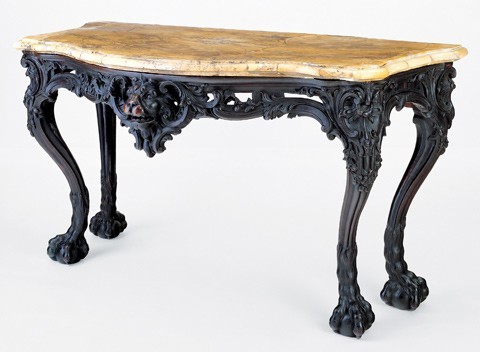
Sideboard table with carving attributed to Martin Jugiez, Philadelphia, Pennsylvania, ca. 1765. Mahogany with white oak; marble. H. 32 1/2", W. 62 3/4", D. 31 5/8". (Courtesy, Philadelphia Museum of Art; photo, Gavin Ashworth.) All dimensions were taken from the frame. The pieces of figured marble veneer forming the top are bonded to a gray stone core with a roughly worked rear edge. The solid molded edges are attached to the core in a manner similar to cross-banded moldings on wooden tops. The top has a complex history of breakage and repair. Most of the veneer pieces at the ends and all of the side moldings have been replaced; iron and steel splints have been added to the undersurface; and losses on the top have been filled.
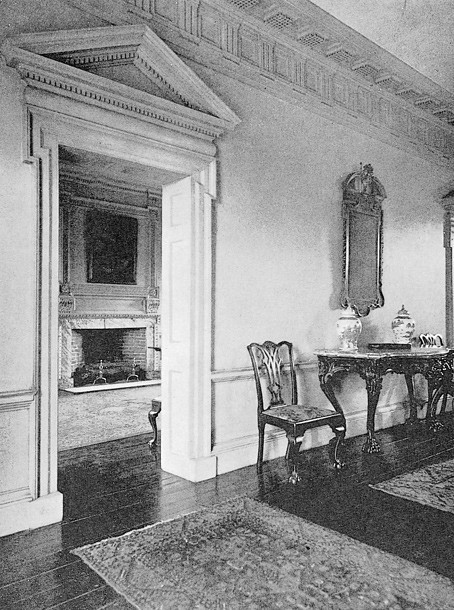
View of the hall in Mount Pleasant showing the sideboard table illustrated in fig. 1. (Philip B. Wallace, Colonial Houses: Philadelphia, Pre-Revolutionary Period [New York: Architectural Book Publishing Co., 1931], p. 157.)

Elevation of the north façade of the Pennsylvania State House shown on Matther A. Lotter, A PLAN of the City and Environs of PHILADELPHIA, Pennsylvania, 1777. (Courtesy, Winterthur Museum.)
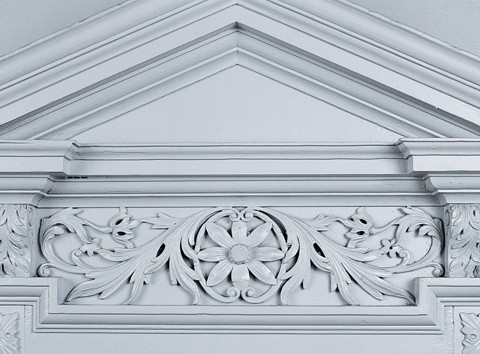
Frieze appliqué in the stair tower of the Pennsylvania State House. (Courtesy, Independence Hall National Historic Site; photo, Gavin Ashworth.)
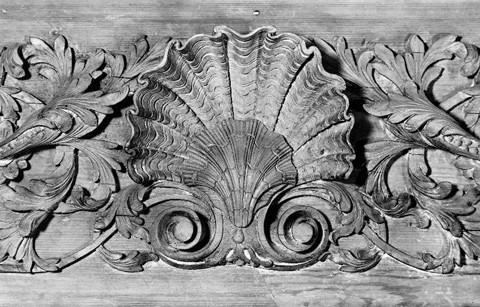
Detail of the appliqué on the frieze of the tabernacle frame in the Assembly Room of the Pennsylvania State House. (Courtesy, Independence Hall National Historic Site.)
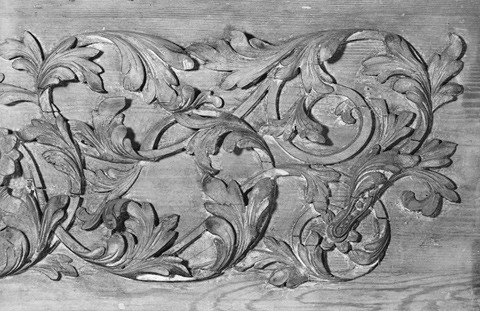
Detail of the appliqué on the frieze of the tabernacle frame in the Assembly Room of the Pennsylvania State House. (Courtesy, Independence Hall National Historic Site.)

Desk-and-bookcase with carving attributed to the shop of Samuel Harding, Philadelphia, Pennsylvania, 1740–1755. Walnut with tulip poplar, yellow pine, and white cedar. H. 112", W. 40 3/4", D. 23 3/4". (Chipstone Foundation; photo, Gavin Ashworth.)

Detail of the tympanum appliqué on the desk-and-bookcase illustrated in fig. 7. (Photo, Gavin Ashworth.) The appliqués on either side of the bookcase shell are so undercut that they make little contact with the tympanum and appear to float over it.
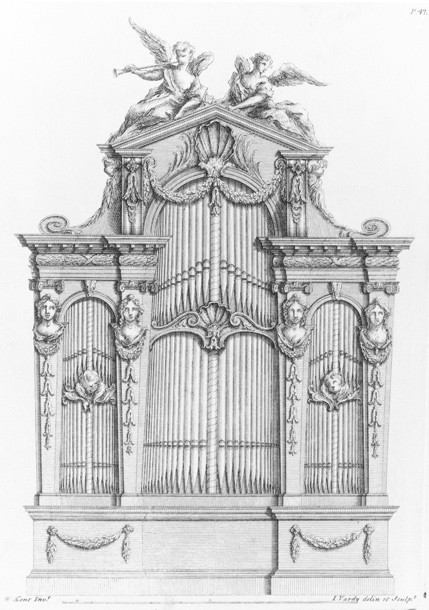
Design for an organ case illustrated on pl. 47 in John Vardy’s Some Designs of Mr. Inigo Jones and Mr. William Kent (1744). The engravings in this book depict Kent’s designs from the early 1730s.
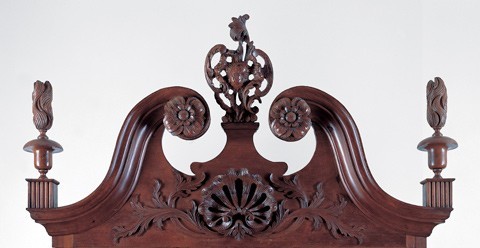
Detail of a tympanum appliqué attributed to Nicholas Bernard, Philadelphia, Pennsylvania, probably late 1740s. (Private collection; photo, Gavin Ashworth.) The appliqué is on the upper section of a high chest or chest-on-chest attributed to the shop of Philadelphia cabinetmakers Henry Cliffton and Thomas Carteret. The lower section is missing.
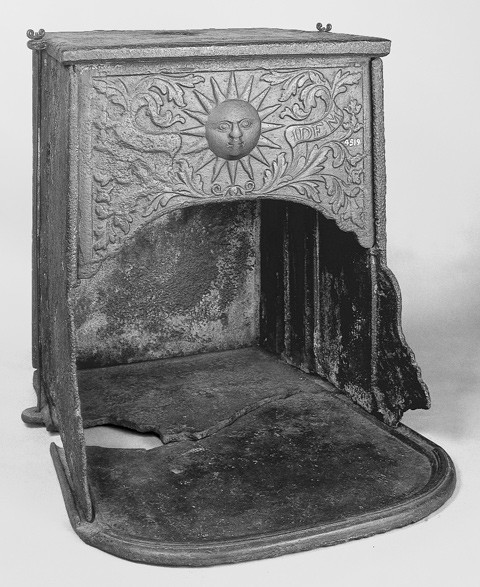
Franklin stove, attributed to Warwick or Mount Pleasant Furnace, Chester or Berks County, Pennsylvania, ca. 1745. Cast iron. H. 31 1/2", W. 27 1/2", D. 35 3/4". (Courtesy, Mercer Museum of the Doylestown Historical Society; photo, Philadelphia Museum of Art.)

James Turner (act. 1744–1759) after Lewis Evans, design for Franklin’s Stove, illustrated in An Account of the New Invented Pennsylvanian Fire-places. (Courtesy, Library Company of Philadelphia; photo, Philadelphia Museum of Art.)

High chest with carving attributed to Nicholas Bernard, Philadelphia, Pennsylvania, probably late 1740s. Walnut with tulip poplar, yellow pine, and white cedar. H. 91 1/2", W. 42 1/2", D. 24 1/2". (Private collection; photo, Philip Bradley Antiques.) The construction, knee carving, and underscale claw-and-ball feet on this piece have parallels in other Philadelphia case pieces from the mid- to late 1740s.
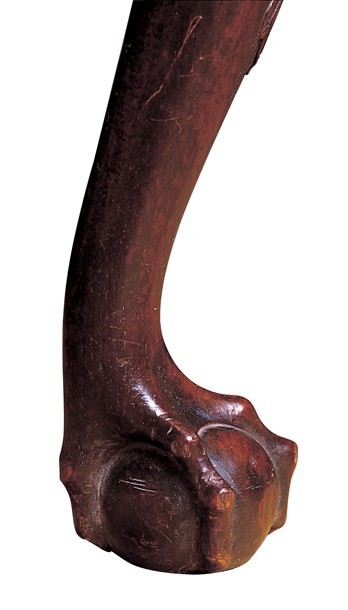
Detail of the right front foot of the high chest illustrated in fig. 13. (Photo, Gavin Ashworth.) The feet of this chest are similar to those on the side chair illustrated in fig. 16.

Detail of the intaglio carving in the upper chamfer returns of the high chest illustrated in fig. 13. (Photo, Gavin Ashworth.) This is the earliest intaglio carving associated with Nicholas Bernard. No other pieces with incising in this context are known.
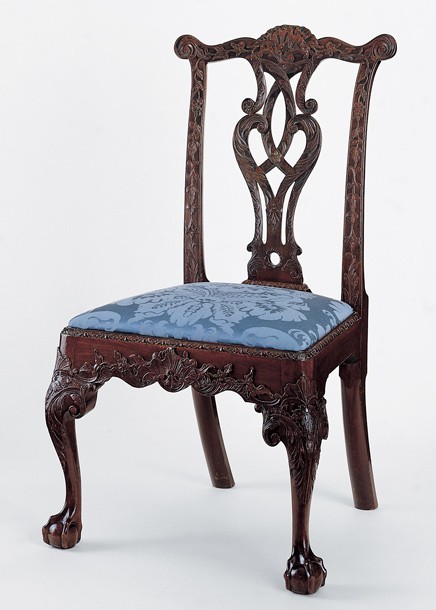
Side chair with carving attributed to Nicholas Bernard, Philadelphia, Pennsylvania, ca. 1750. Mahogany with white cedar. H. 41 1/2", W. 22 3/8, D. 17 1/2". (Courtesy, Philadelphia Museum of Art; photo, Gavin Ashworth.) The feet of this chair are related to those on the earliest case furniture attributed to Bernard (see figs. 13, 14). They do not occupy the full thickness of the stock and have an extra joint in the rear talon.
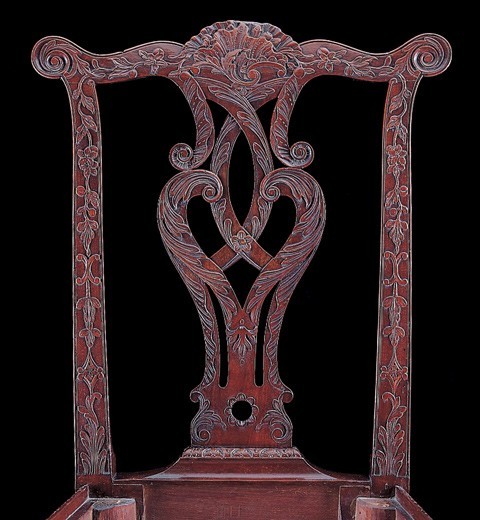
Detail of the back of the side chair illustrated in fig. 16. (Photo, Gavin Ashworth.)
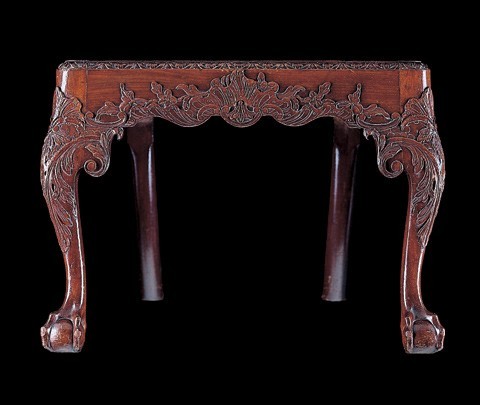
Detail of the carving on the front rail and knees of the side chair illustrated in fig. 16. (Photo, Gavin Ashworth.)
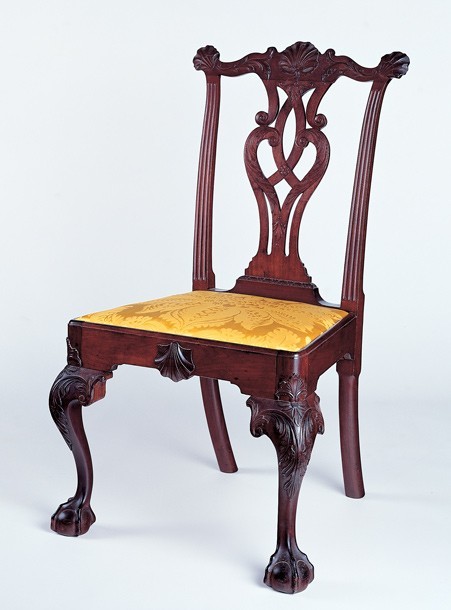
Side chair with carving attributed to Nicholas Bernard, Philadelphia, Pennsylvania, ca. 1755. Mahogany with white cedar. Dimensions not recorded. (Private collection; photo, Gavin Ashworth.) The feet of this chair are larger than those on the Lambert chairs (see fig. 16) and are more typical of Philadelphia work from the 1750s. They occupy the full thickness of the stock, are more in scale with the leg, and do not have the extra rear knuckle. The carving on the back and knees activates the form, whereas the ornament on the Lambert chairs is simply visual static. Three of Bernard’s competitors carved chairs of this same basic design.
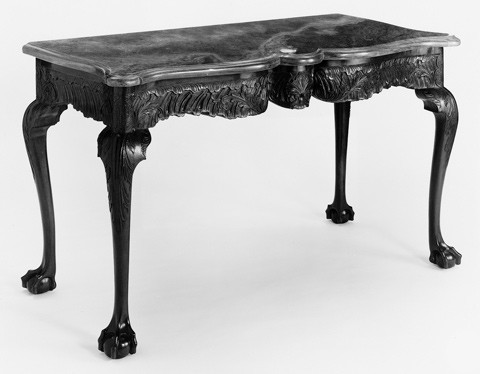
Sideboard table with carving attributed to Nicholas Bernard, Philadelphia, Pennsylvania, 1750–1755. Mahogany with yellow pine and tulip poplar. H. 29 1/4", W. 49 1/2", D. 20 3/4". (Courtesy, Winterthur Museum, gift of Claneil Foundation in memory of Lois McNeil.) This sideboard table is one of three related examples. For the rails of these tables, Bernard used complex background designs with foreground elements intended to dominate the flow of line.

Detail of the carving on the rail of the sideboard table illustrated in fig. 20.
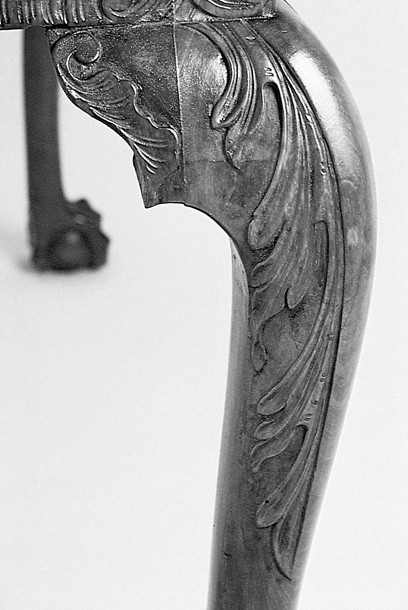
Detail of the knee carving on the sideboard table illustrated in fig. 20.
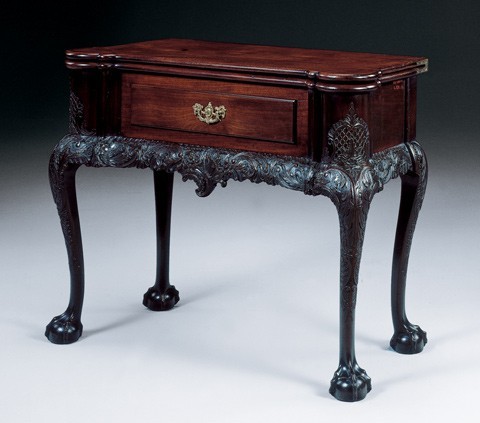
Card table with carving attributed to Nicholas Bernard, Philadelphia, Pennsylvania, 1750–1755. H. 28 1/2", W. 36", D. 17" (closed). (Private collection; photo, Christie’s.)

Card table with carving attributed to the “Garvan high chest carver,” Philadelphia, Pennsylvania, probably late 1750s. H. 29", W. 36", D. 16 3/4" (closed). (Chipstone Foundation; photo, Gavin Ashworth.)
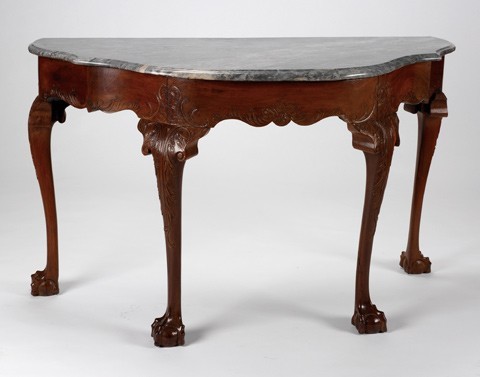
Sideboard table with carving attributed to Nicholas Bernard, Philadelphia, Pennsylvania, ca. 1755. Mahogany with unidentified secondary woods; clouded limestone. H. 29 1/2", W. 49 7/8", D. 22 1/2". (Courtesy, Pendleton House Collection, Rhode Island School of Design.)
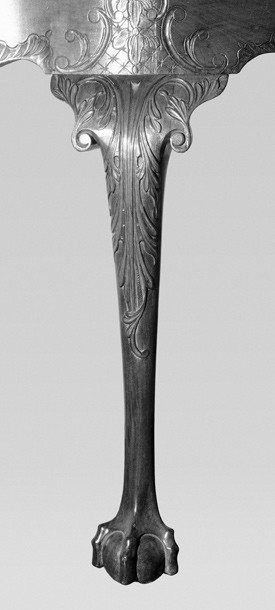
Detail of the knee carving on the sideboard table illustrated in fig. 25. (Photo, Luke Beckerdite.)
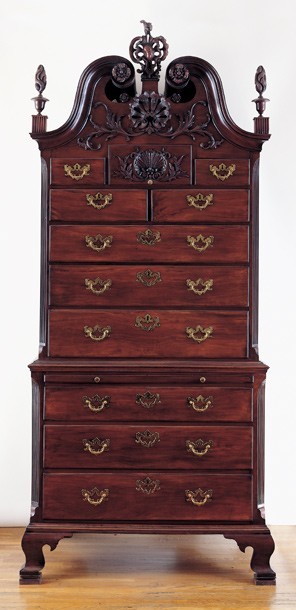
Chest-on-chest with carving attributed to Nicholas Bernard, Philadelphia, Pennsylvania, 1755–1760. Mahogany with tulip poplar, yellow pine, and white cedar. H. 97", W. 42 1/4", D. 24". (Courtesy, Historical Society of Dauphin County, Harrisburg, Pa.; photo, Gavin Ashworth.)
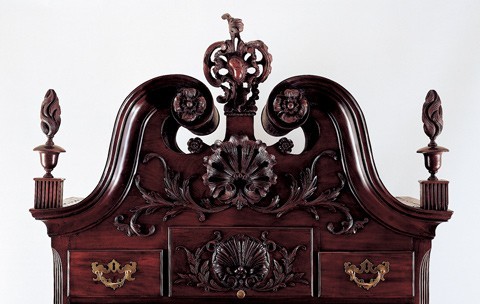
Detail of the pediment of the chest-on-chest illustrated in fig. 27. (Photo, Gavin Ashworth.) Bernard used a pattern to lay out his cartouche ornaments. Occasionally he flipped the pattern to make the ornament face in the opposite direction.
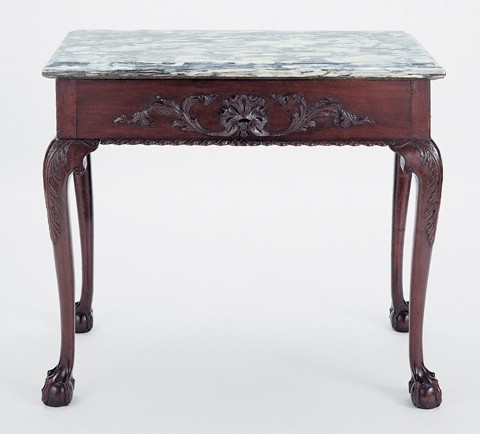
Sideboard table with carving attributed to Nicholas Bernard, Philadelphia, Pennsylvania, 1755–1760. Mahogany. H. 30 3/4", W. 36", D. 19 3/4". (Courtesy, Winterthur Museum, gift of Henry Francis du Pont.)
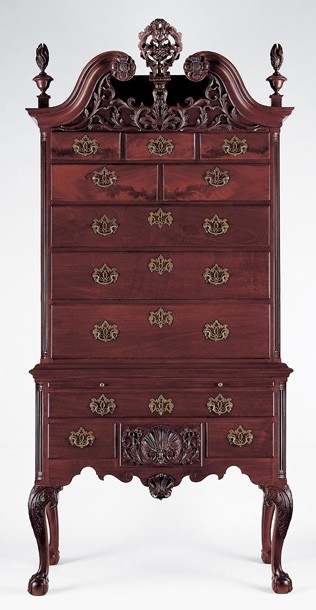
High chest of drawers with carving attributed to Nicholas Bernard and Martin Jugiez, Philadelphia, Pennsylvania, ca. 1760. Mahogany with tulip poplar, yellow pine, and white cedar. H. 94", W. 44", D. 23". (Private collection; photo, Gavin Ashworth.)
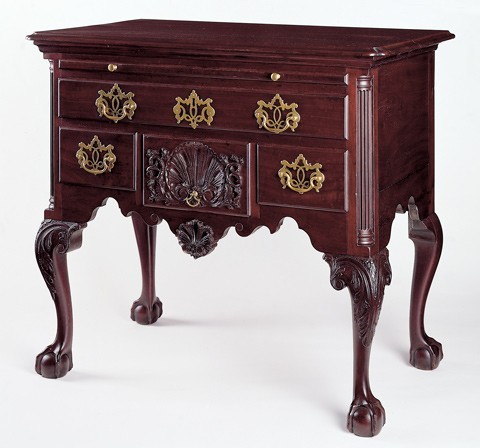
Dressing table with carving attributed to Nicholas Bernard, Philadelphia, Pennsylvania, ca. 1760. Mahogany with tulip poplar, yellow pine, and white cedar. H. 32", W. 36", D. 21". (Private collection; photo, Gavin Ashworth.) All of the carving on the dressing table is attributed to Nicholas Bernard.
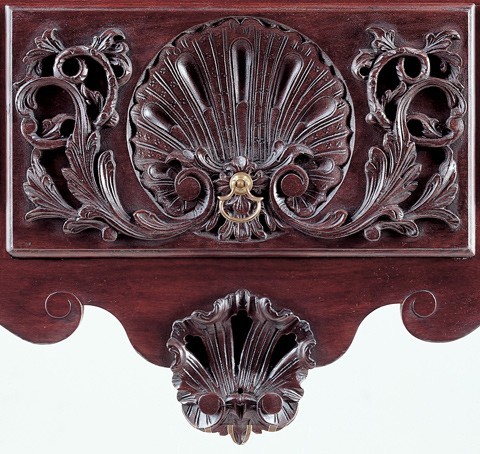
Detail of the relief-carved shell and flanking appliqués on the lower center drawer of the high chest illustrated in fig. 30.
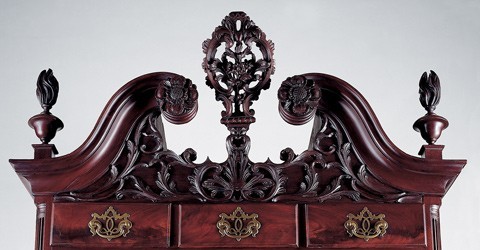
Detail of the pediment of the high chest illustrated in fig. 30. (Photo, Gavin Ashworth.) The double C-scroll ornament diVers significantly from the asymmetrical ones attributed to Bernard and their more elegant counterparts produced by the “Garvan high chest carver.”
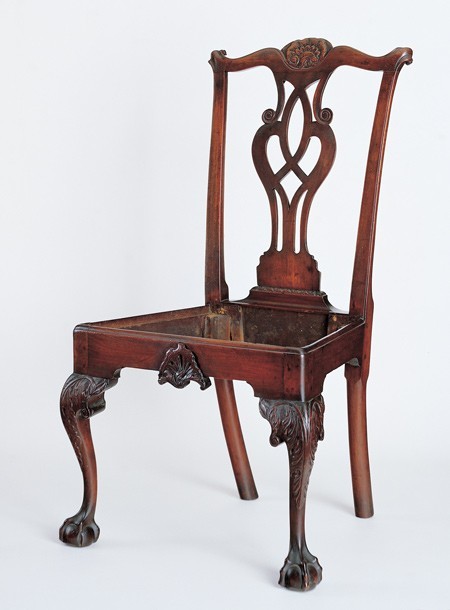
Side chair with carving attributed to Nicholas Bernard, 1755–1760. Mahogany with tulip poplar and white cedar. H. 40 1/2", W. 21 1/4", D. 16 3/4". (Courtesy, Philadelphia Museum of Art; photo, Gavin Ashworth.) This side chair and the example illustrated in fig. 36 share several construction features. The spaces created by their overlapping shoes are filled with thin glue blocks. These blocks also serve as the foundation for the larger quarter-round blocks glued inside the rear corners of the seat frame. The asymmetrical carving on the crest rail of this chair is virtually identical to that on several other chairs attributed to Bernard, and the shell on the front seat rail is similar to that in the center of the front rail of the card table illustrated in fig. 23.
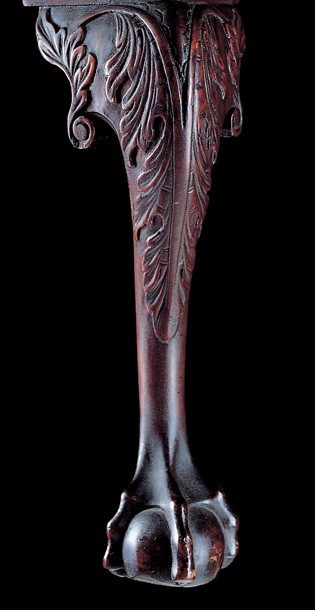
Detail of the knee carving on the side chair illustrated in fig. 34. (Photo, Gavin Ashworth.)
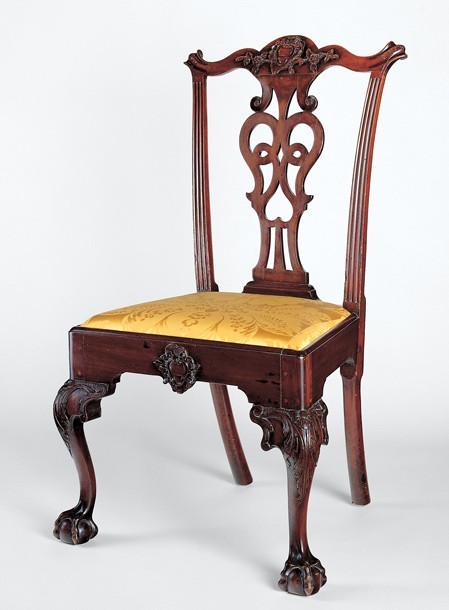
Side chair with carving attributed to Martin Jugiez, 1760–1765. Mahogany with yellow pine and white cedar. H. 40", W. 21 7/8", D. 16 3/4". (Private collection; photo, Gavin Ashworth.) Although the carving on the crest rail and front seat rail is exceptional, the knee acanthus is relatively coarse. In general, eighteenth-century carvers expended more effort on ornament that was closer to the eye.
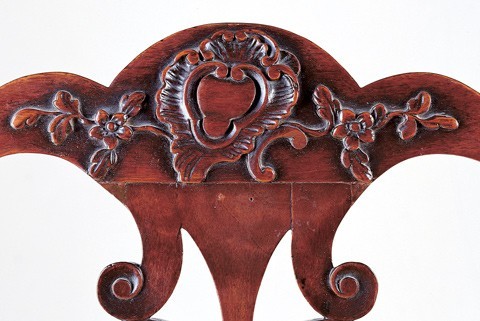
Detail of the cartouche on the crest rail of the side chair illustrated in fig. 36. (Photo, Gavin Ashworth.)

Chest-on-chest with carving attributed to Martin Jugiez, Philadelphia, Pennsylvania, 1760–1765. Mahogany with tulip poplar, yellow pine, and white cedar. H. 95 3/8, W. 39 1/2", D. 24". (Private collection; photo, Gavin Ashworth.)
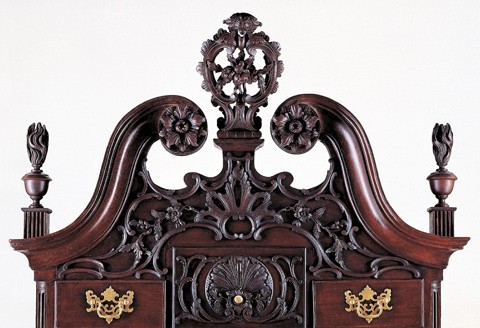
Detail of the pediment of the chest-on-chest illustrated in fig. 38. (Photo, Gavin Ashworth.)
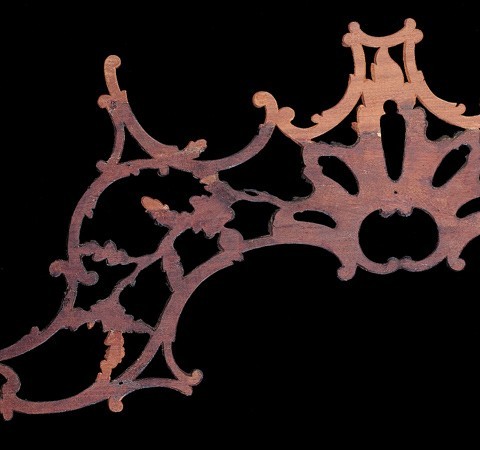
Detail showing the back of the tympanum appliqué on the chest-on-chest illustrated in fig. 38. (Photo, Gavin Ashworth.)

Tall clock case with carving attributed to Martin Jugiez, Philadelphia, Pennsylvania, c. 1770. Mahogany with white cedar. H. 97 1/2", W. 21 3/4", D. 12 5/8". (Chipstone Foundation; photo, Gavin Ashworth.) The movement is from the shop of London clockmaker William Addis, and the dial arch is inscribed “THE PHILADELPHIA PACKETT.”
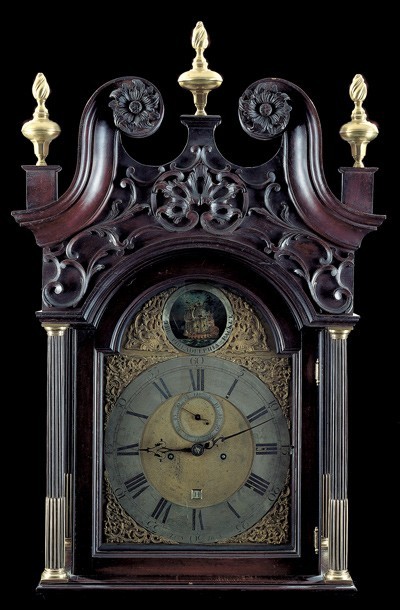
Detail of the hood of the tall clock case illustrated in fig. 41. (Photo, Gavin Ashworth.)

Side chair with carving attributed to Martin Jugiez, Philadelphia, Pennsylvania, ca. 1765. Mahogany. H. 39 1/2", W. 25 1/2", D. 23 1/2". (Chipstone Foundation; photo, Gavin Ashworth.)
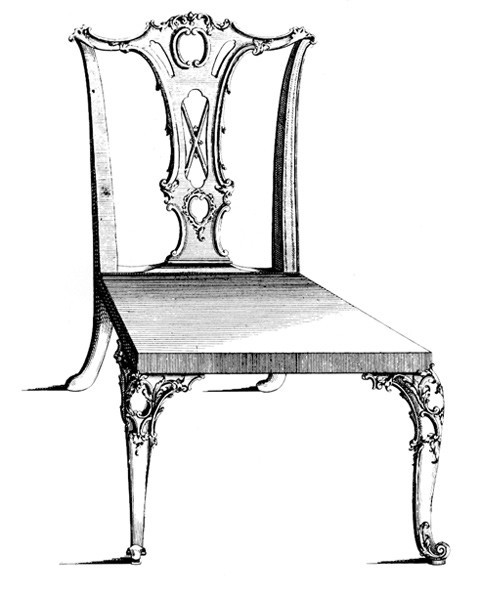
Design for a side chair shown on pl. 12 of the first and second editions of Thomas Chippendale’s The Gentleman and Cabinet-Maker’s Director (1754, 1755). (Courtesy, Winterthur Library.) This design appeared on pl. 14 in the third edition (1764).

Detail of the carving on the leg and foot of the side chair illustrated in fig. 43. (Photo, Gavin Ashworth.)
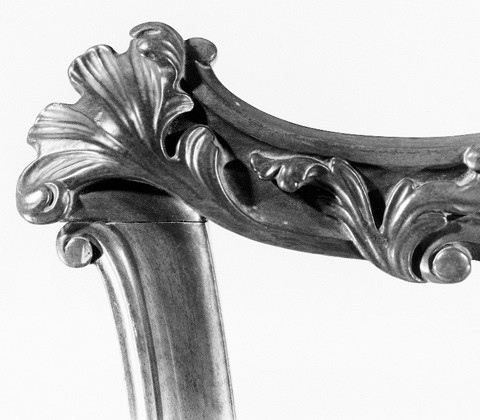
Detail of the left ear on the crest rail of the side chair illustrated in fig. 43. (Photo, Gavin Ashworth.)
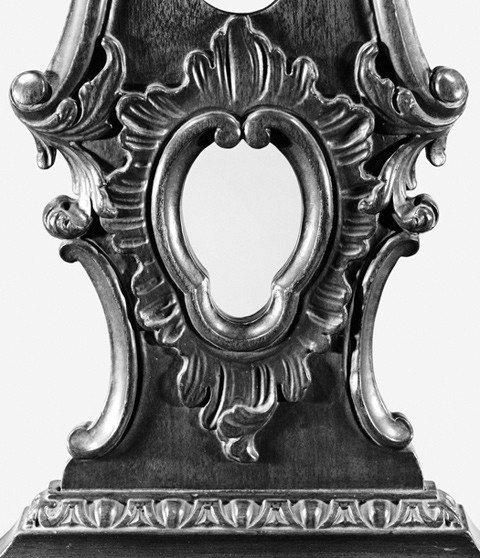
Detail of the carving on the splat of the side chair illustrated in fig. 43. (Photo, Gavin Ashworth.)
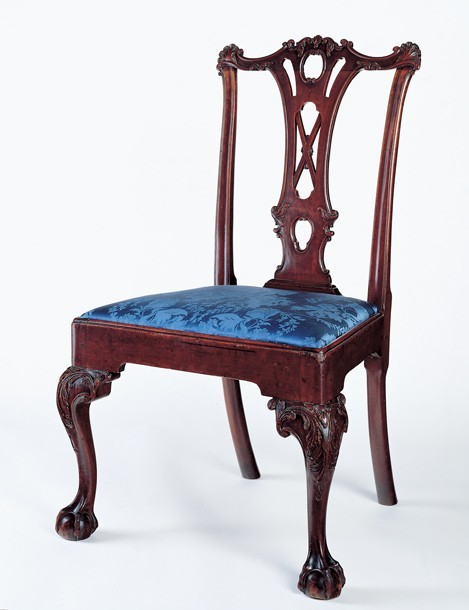
Side chair with carving attributed to Martin Jugiez, Philadelphia, Pennsylvania, ca. 1765. Mahogany with yellow pine and white cedar. H. 40 3/8, W. 22 7/8", D. 17 3/4". (Chipstone Foundation; photo, Gavin Ashworth.)

Detail showing the carving on the claw-and-ball-foot side chair (above) and scroll-foot side chair (below) attributed to Jugiez (figs. 43, 48). (Photo, Gavin Ashworth.)
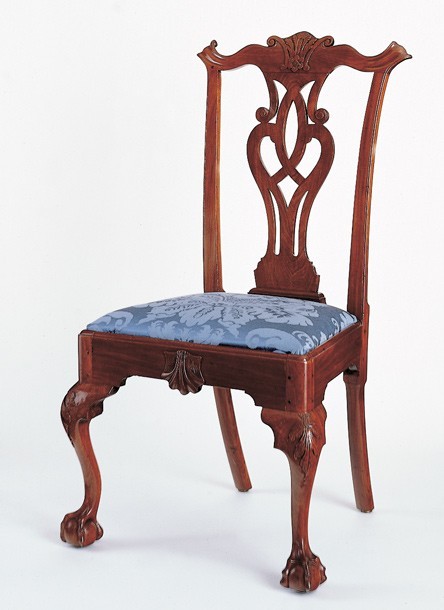
Side chair with carving attributed to Martin Jugiez, Philadelphia, Pennsylvania, 1765–1775. Mahogany with white cedar. H. 41 1/2", W. 21 7/16", D. 16 3/8. (Courtesy, Philadelphia Museum of Art; photo, Gavin Ashworth.)

Detail of the knee carving on the side chair illustrated in fig. 50. (Photo, Gavin Ashworth.)
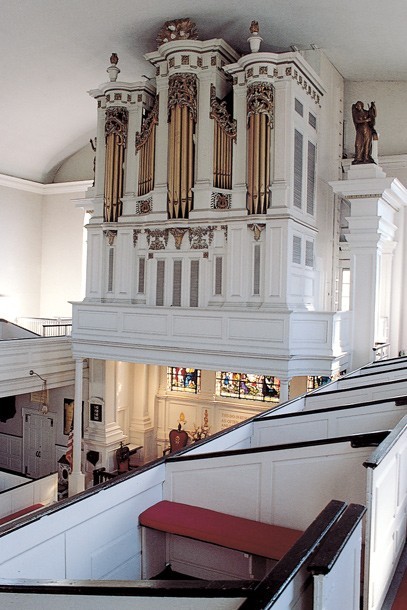
Interior of St. Peter’s Church, Philadelphia, Pennsylvania, ca. 1763, with organ and case installed ca. 1764. (Courtesy, St. Peter’s Church; photo, Luke Beckerdite.)

Detail of the carving around the pipes of the organ case illustrated in fig. 52. (Photo, Luke Beckerdite.)

Detail of the carving on the lower section of the organ case illustrated in fig. 52. (Photo, Luke Beckerdite.)

View of the second-floor parlor in Mount Pleasant, Philadelphia, Pennsylvania, ca. 1764. (Courtesy, Philadelphia Museum of Art; photo, Gavin Ashworth.) The large appliqué between the trusses on the chimneypiece is missing, but clear witness marks survive.

Detail of the large tympanum appliqué on the chimneypiece illustrated in fig. 55. (Photo, Gavin Ashworth.) The small flower at the top of the appliqué came from the side of a truss and is incorrect for the design.
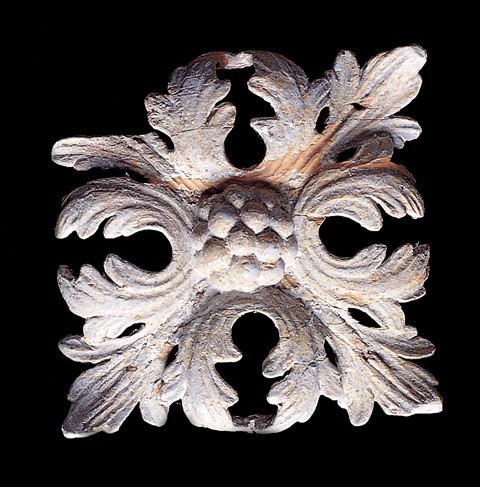
Detail of the upper left flower at the top of the chimneypiece illustrated in fig. 55. (Photo, Gavin Ashworth.)
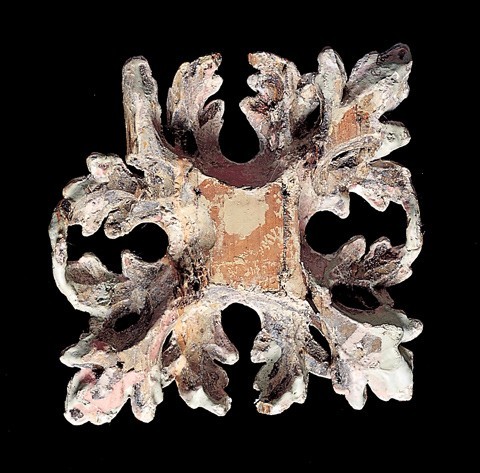
Detail of the back of the flower illustrated in fig. 57. (Photo, Gavin Ashworth.)

Detail of the witness marks for the appliqué originally installed on the frieze of the chimneypiece illustrated in fig. 55. (Photo, Gavin Ashworth.)

Detail showing a chimneypiece from Whitby Hall. (Courtesy, Detroit Institute of Arts; City of Detroit Purchase, photograph © 1986.) This appliqué is attributed to the “Garvan high chest carver.” The small flowers in the lower crossetts were copied from examples illustrated on pl. 4 in Abraham Swan’s British Architect (1745).

Fireback, Marlboro Furnace, Frederick County, Virginia, ca. 1770. Cast iron. 34 1/2" x 31". (Courtesy, United States Army Engineer Museum, Fort Belvoir, Virginia; photo, Robert Hinds.)

Finial bust of John Locke attributed to Martin Jugiez, Philadelphia, Pennsylvania, ca. 1770. Mahogany. H. 10 1/2". (Courtesy, Metropolitan Museum of Art, gift of Bernard and S. Dean Levy, Inc. in honor of Bernard Levy, 1992.)
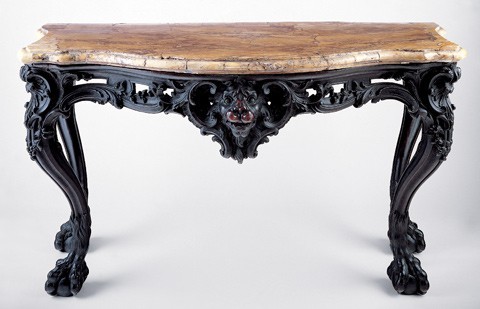
Finial bust of John Locke attributed to Martin Jugiez, Philadelphia, Pennsylvania, ca. 1770. Mahogany. H. 10 1/2". (Courtesy, Metropolitan Museum of Art, gift of Bernard and S. Dean Levy, Inc. in honor of Bernard Levy, 1992.)

Side and frontal views of a model showing the relative stock dimensions and laminate scheme of the sideboard table illustrated in figs. 1, 63. (Photo, Gavin Ashworth.) The surfaces of the front rail behind the laminates were planed.
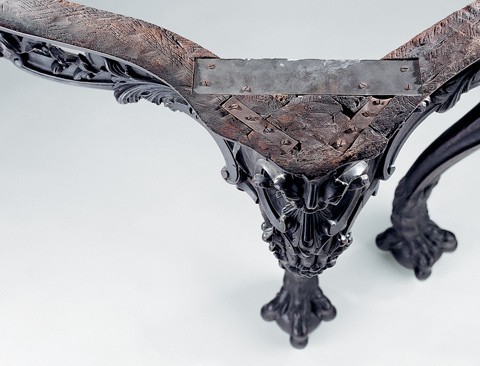
Detail of the hewing marks on the top of the front rail of the sideboard table illustrated in figs. 1, 63. (Photo, Gavin Ashworth.)

Detail showing the inner rails of the sideboard table illustrated in figs. 1, 63. (Photo, Gavin Ashworth.)
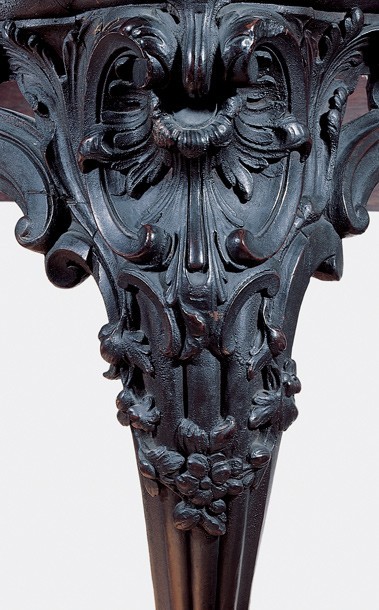
Detail of the carving on the knee of the right front leg of the sideboard table illustrated in figs. 1, 63. (Photo, Gavin Ashworth.) Jugiez carved right over the ends of the pins securing the mortise-and-tenon joints.
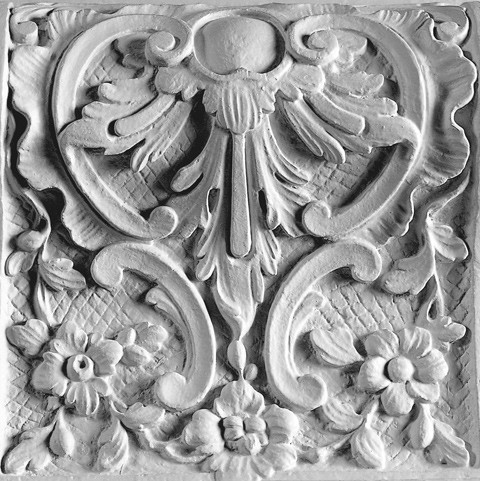
Detail of the right truss of the chimneypiece in the second-floor parlor of Mount Pleasant. (Photo, Gavin Ashworth.) The truss and other carved components are yellow pine.
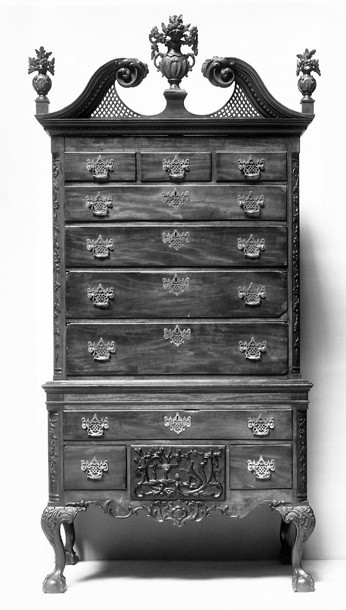
High chest with carving attributed to Martin Jugiez, Philadelphia, Pennsylvania, 1770–1775. Mahogany with yellow pine, tulip poplar, and white cedar. H. 96 3/4", W. 45 1/2", D. 24 1/2". (Courtesy, Philadelphia Museum of Art.)

Detail of the carving on the lower right quarter-column of the high chest illustrated in fig. 69.
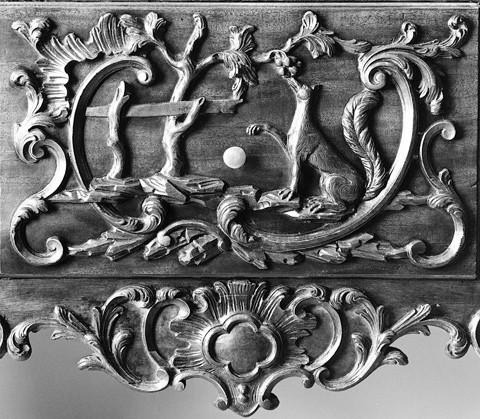
Detail of the carving on the drawer and skirt of the high chest illustrated in fig. 69.
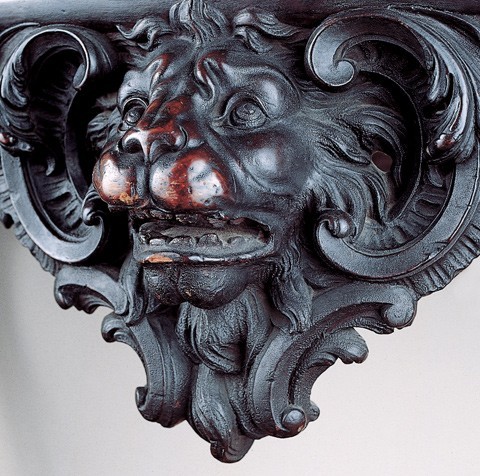
Detail of the lion’s head on the sideboard table illustrated in figs. 1, 63. (Photo, Gavin Ashworth.)

Detail showing the right side of the sideboard table illustrated in figs. 1, 63. (Photo, Gavin Ashworth.)

Design for a sideboard table attributed to Matthias Lock, England, ca. 1745. Pencil on paper. 8 3/4" x 6 7/8". (© V&A Images/Victoria and Albert Museum, London, www.vam.ac.uk.)

Design for a sideboard table attributed to William or John Linnell, England, 1750–1760. Ink and watercolor on paper. 2 1/4" x 4 1/2". (© V&A Images/Victoria and Albert Museum, London, www.vam.ac.uk.) Linnell’s drawing depicts a table in the Palladian style and makes no reference to the prevailing rococo. In the late seventeenth and eighteenth centuries British architects, designers, and their patrons frequently visited Italy on the grand tour. They found inspiration for architecture and case furniture in Roman buildings and works by such later architects as Andrea Palladio but saw no classical tables or seating furniture to emulate. By default, they adopted aspects of contemporary northern Italian furniture design. Linnell’s drawing reflects this stylistic migration, which Jugiez completed when he crossed the Atlantic.
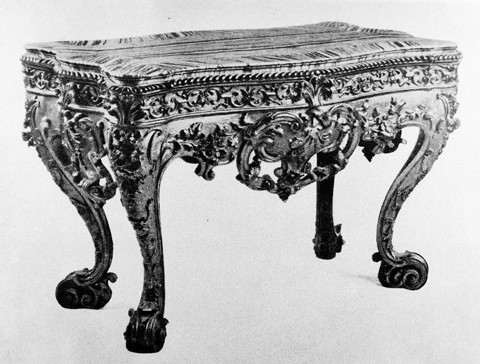
Sideboard table, Italy, 1740–1760. Woods and dimensions not recorded. (Giuseppe Morazzoni, Il Mobile Veneziano [Milan: Görlich, 1958], pl. 155.)
